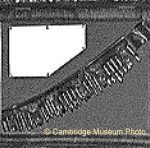Cambridge Collections
South African War Veterans

6,495 men from New Zealand went to the South African War 1899-1902. There were 228 New Zealand deaths – 59 killed in action, 11 died of wounds, 25 from accidents and 133 from disease. 166 were wounded.
35 men left from Cambridge.
The South African War Veterans’ Association dated back to 22 September 1920 and had grown from two previous organisations, which kept together the members of different contingents. Their badge of office was a bandolier originally worn by the first New Zealand soldier killed in action in this foreign war, Farrier George Rowland Bradford from Paeroa.
Over 70 Veterans were given ‘The Freedom Of The Town’ in 1965 and the Cambridge RSA rolled out the welcome mat giving the clubrooms as the Head Quarters for the reunion week. At that time two Veterans were in Cambridge; Sam Lewis who had paid his own way to South Africa and enlisted with the Colonial Light Horse Regiment and W ‘Dinah’ Thompson who enlisted in Kihikihi and served with the Rough Riders in the 9th Contingent.
A conference and reunion was held in February each year to celebrate the signing of the peace treaty. Cambridge was the venue when the Waikato branch hosted this event in February 1965.
The Cambridge Women’s Section entertained the Waikato branch in 1967 and Tom Wallace was presented with a fern leaf badge, which signified honorary membership of the NZ Association for unselfish service given to the veterans. He was closely associated with the Waikato Branch and Dominion Headquarters for 15 years, including six years as Dominion Treasurer and representative on the Disabled Servicemen’s Establishment League.
In 1970 Cambridge again hosted the New Zealand annual reunion and conference. There were still 150 members with Sam Lewis, then aged 92, president of the Waikato Branch. At the social gathering, again in the RSA clubrooms, there were soldiers from five different wars and the South African Veterans were given Honorary Membership.
By 1973 Australia, Britain and Canada’s Associations had folded and Sam Lewis at 95 years of age was the New Zealand president. They held their final reunion in Palmerston North, being the same venue of the first Boer War Soldiers reunion more than 70 years before. There were still 60 members but only 12 (all in their nineties) could make the reunion. The members continued to meet at social gatherings in different parts of the country.
In October 1974 the Cambridge RSA was honoured to have the South African War Veterans’ badge of office, The Bandolier, hung in the Clubrooms for safekeeping. This had been worn by 34 presidents, each having a suitably inscribed ·303 silver plated bullet added to the bandolier.
It was claimed at this ceremony that Tommy Hampshire was responsible for the first government pension for a South African War Veteran. It was in 1928 when a South African Veteran in Cambridge suffered an injury which incapacitated him and brought consequent financial difficulties. Mr Hampshire who was secretary of the Cambridge Ex-Servicemen’s Relief Association, made an appointment to meet the Prime Minister Gordon Coates in Auckland.
After he had heard the story, the Prime Minister immediately announced that £200 would be placed on the estimates to aid needy South African War Veterans. “This was the first Government aid these men ever received”, stated Mr Hampshire, “Previously they had relied on charity when in dire straits”.
One of the last official acts of the 20 remaining veterans was in 1976, when Lieutenant Colonel Tom Wallace made the presentation of the last ever gold badge, the highest honour of the South African War Veterans’ Association to Governor-General Sir Denis Blundell. He was their last patron.
Their magazine ‘The Veteran” ran annually from October 1925 until May 1978, the costs over the last ten years being met by the NZ RSA, enabling free distribution to SAV members. This magazine not only served as the voice of the Association, but also provided a permanent memorial to the Veterans of the South African War.
In June 1980 on the winding up of the South African War Veterans’ Association it was decided that the Bandolier be given to the QE11 Army Memorial Museum at Waiouru. Four veterans were still alive, two of them over 100 years of age. On 27 June 1981 the last veteran of the New Zealand contingent died. He was George Albert Tuck born in Cambridge on 13th February 1884. (He left Cambridge as a young man.)
